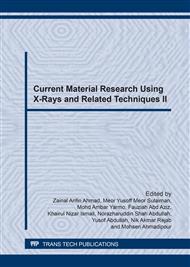p.435
p.441
p.447
p.453
p.458
p.462
p.466
p.471
p.479
Preliminary Determination of Minerals in Mukah Coal
Abstract:
Coal is still one of the major energy sources. It is used as a reducing agent in the metallurgical industry, in the cement industry coal is a source of energy and it is still used in power generation. Mukah coal is characterized through chemical and mineralogical properties determinations. XRD pattern of the coal shows that it is amorphous in nature and dominated by quartz and kaolinite. Mukah coal has about total carbon 97.98 wt% with SiO2, Al2O3 and Fe2O3 present as the most predominant oxides. The oxides make up approximately 1.58 wt% of the coal samples. The SEM image shows basically depicts coal particles of various irregular shapes and sizes. The mineral matter was not clearly seen on the surface of the coal particle as it was supposedly embedded inside the bulk of carbonaceous matter.
Info:
Periodical:
Pages:
458-461
Citation:
Online since:
March 2017
Authors:
Keywords:
Price:
Сopyright:
© 2017 Trans Tech Publications Ltd. All Rights Reserved
Share:
Citation:


